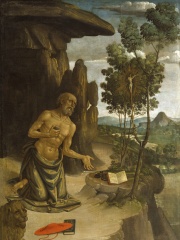
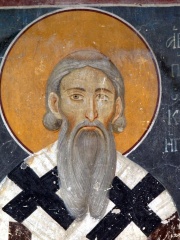
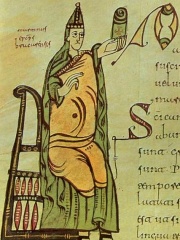
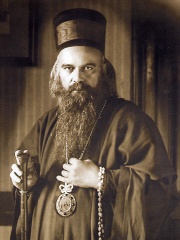
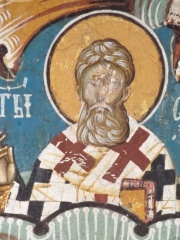
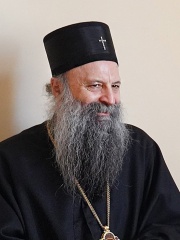
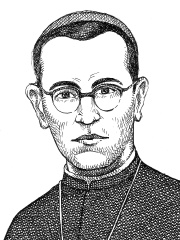
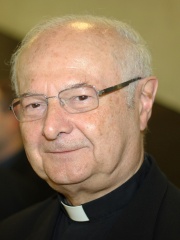
The Most Famous
RELIGIOUS FIGURES from Serbia
This page contains a list of the greatest Serbian Religious Figures. The pantheon dataset contains 3,187 Religious Figures, 9 of which were born in Serbia. This makes Serbia the birth place of the 41st most number of Religious Figures behind Bulgaria, and Lithuania.
Top 9
The following people are considered by Pantheon to be the most legendary Serbian Religious Figures of all time. This list of famous Serbian Religious Figures is sorted by HPI (Historical Popularity Index), a metric that aggregates information on a biography's online popularity.

1. Jerome (345 - 420)
With an HPI of 82.20, Jerome is the most famous Serbian Religious Figure. His biography has been translated into 86 different languages on wikipedia.
Jerome (; Latin: Eusebius Sophronius Hieronymus; Ancient Greek: Εὐσέβιος Σωφρόνιος Ἱερώνυμος; c. 342–347 – 30 September 420), also known as Jerome of Stridon, was an early Christian priest, confessor, theologian, translator, and historian; he is commonly known as Saint Jerome. He is best known for his translation of the Bible into Latin (the translation that became known as the Vulgate) and his commentaries on the whole Bible. Jerome attempted to create a translation of the Old Testament based on a Hebrew version, rather than the Septuagint, as prior Latin Bible translations had done. His list of writings is extensive. In addition to his biblical works, he wrote polemical and historical essays, always from a theologian's perspective. Jerome was known for his teachings on Christian moral life, especially those in cosmopolitan centers such as Rome. He often focused on women's lives and identified how a woman devoted to Jesus should live her life. This focus stemmed from his close patron relationships with several prominent female ascetics who were members of affluent senatorial families. In addition, his works are a crucial source of information on the pronunciation of the Hebrew language in Byzantine Palestine. Jerome is recognized as a saint and Doctor of the Church by the Catholic Church, and as a saint in the Eastern Orthodox Church, the Lutheran Church, and the Anglican Communion. His feast day is 30 September (Gregorian calendar).

2. Saint Sava (1169 - 1236)
With an HPI of 75.83, Saint Sava is the 2nd most famous Serbian Religious Figure. His biography has been translated into 43 different languages.
Saint Sava (Serbian Cyrillic: Свети Сава, romanized: Sveti Sava, Serbian pronunciation: [sʋɛ̂ːtiː sǎːʋa]; 1169 or 1174 – 14 January 1235), known as the Enlightener or the Illuminator, was a Serbian prince and Orthodox monk who became the first Archbishop of the autocephalous Serbian Church. He was also a writer, diplomat, and the founder of Serbian law. Sava, born as Rastko Nemanjić (Serbian Cyrillic: Растко Немањић), was the youngest son of Serbian Grand Prince Stefan Nemanja (founder of the Nemanjić dynasty), and ruled the appanage of Zachlumia briefly in 1190–92. He then left for Mount Athos, where he became a monk and took the monastic name Sava (Sabbas). At Athos he established the monastery of Hilandar, which became one of the most important cultural and religious centres of the Serbian people. In 1219, the Patriarchate exiled in Nicea recognized him as the first Serbian Archbishop, and in the same year, he authored the oldest known constitution of Serbia, the Zakonopravilo nomocanon, thus securing full religious and political independence. Sava is regarded as the greatest figure of Serbian medieval literature and author of the first Serbian "biography". Specifically, he wrote the life of his father, the Serbian ruler Stefan Nemanja. He is widely considered one of the most important figures in Serbian history. The Serbs regard Sava as what Averroes is to the Muslims and Maimonides is to the Jews by virtue of their respective lives and achievements. Saint Sava is venerated by the Eastern Orthodox Church on January 27 [O.S. January 14]. Many artistic works from the Middle Ages to modern times have interpreted his life. He is the patron saint of Serbia, Serbs, Serbian education, and medicine. The Church of Saint Sava in Belgrade is dedicated to him, built on the site where the Ottomans burnt his remains in 1594, during an uprising in which Serbs used icons of Sava as their war flags; the church is one of the largest church buildings in the world. To distinguish him from other saints and canonized Serbian archbishops of the same name, he is also posthumously titled Saint Sava I of Serbia.

3. Martin of Braga (520 - 580)
With an HPI of 66.01, Martin of Braga is the 3rd most famous Serbian Religious Figure. His biography has been translated into 23 different languages.
Saint Martin of Braga (in Latin Martinus Bracarensis, in Portuguese, known as Martinho de Dume c. 520–580 AD), also known as Saint Martin of Dumio, was an archbishop of Bracara Augusta in Gallaecia (now Braga in Portugal), a missionary, a monastic founder, and an ecclesiastical author. According to his contemporary, the historian Gregory of Tours, Martin was plenus virtutibus ("full of virtue") and in tantum se litteris imbuit ut nulli secundus sui temporis haberetur ("he so instructed himself in learning that he was considered second to none in his lifetime"). He was later canonized by the Catholic Church for his work in converting the inhabitants of Gallaecia to Chalcedonian Christianity, being granted the cognomen of "Apostle to the Suevi". His feast day is 20 March.

4. Nikolaj Velimirović (1880 - 1956)
With an HPI of 64.70, Nikolaj Velimirović is the 4th most famous Serbian Religious Figure. His biography has been translated into 20 different languages.
Nikolaj Velimirović (Serbian Cyrillic: Николај Велимировић; 4 January 1881 [O.S. 23 December 1880] – 18 March [O.S. 5 March] 1956) was a Serbian Orthodox prelate who served as Bishop of Ohrid and Žiča from 1920 to 1956. An influential theological writer and a gifted orator, he was often referred to as the "new John Chrysostom". According to a number of historians he is one of the most influential bishops of the Serbian Orthodox Church in the twentieth century. As a young man, he came close to dying of dysentery and decided that he would dedicate his life to God if he survived. He lived and was tonsured as a monk under the name Nikolaj in 1909. He was ordained into the clergy, and quickly became an important leader and spokesman for the Serbian Orthodox Church, especially in its relations with the West. When Nazi Germany occupied Yugoslavia in World War II, Velimirović was imprisoned and eventually taken to Dachau concentration camp. After being released by Germans in December 1944, Velimirović spent time in Slovenia, where he blessed anti-communist volunteers such as Dimitrije Ljotić and other Nazi collaborators. After the war, he moved to the United States in 1946, where he remained until his death in 1956. He strongly supported the unity of all Eastern Orthodox churches and established particularly good relationships with the Anglican and Episcopal Churches. Nikolaj is held in high regard in the Serbian Orthodox Church and among Serbian right-wing political elite. On 24 May 2003, he was glorified as a saint by the Holy Synod of the Serbian Orthodox Church as Saint Nikolaj of Ohrid and Žiča (Serbian: Свети Николај Охридски и Жички, romanized: Sveti Nikolaj Ohridski i Žički). Many of his views and writings remain controversial. Nikolaj's critics point out to instances of antisemitism in his work, to his early admiration of Adolf Hitler and to his links with Ljotić.
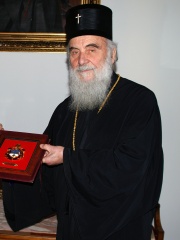
5. Irinej, Serbian Patriarch (1930 - 2020)
With an HPI of 64.03, Irinej, Serbian Patriarch is the 5th most famous Serbian Religious Figure. His biography has been translated into 32 different languages.
Irinej (Serbian Cyrillic: Иринеј, pronounced [irǐneːj], English: Irenaeus; born Miroslav Gavrilović; 28 August 1930 – 20 November 2020) was the head of the Serbian Orthodox Church from 2010 until his death in 2020. He had first been the bishop of Niš between 1975 and 2010, and then the patriarch of the Serbian Orthodox Church from 22 January 2010 succeeding Pavle, until his death. He was considered, both abroad and at home, to be a moderate traditionalist, open to global inter-religious dialogue.

6. Sava II (1199 - 1269)
With an HPI of 59.36, Sava II is the 6th most famous Serbian Religious Figure. His biography has been translated into 20 different languages.
Saint Sava II (Serbian: Свети Сава II, romanized: Sveti Sava II; 1201–1271) was the third archbishop of the Serbian Orthodox Church, serving from 1263 until his death in 1271. He was the middle son of King Stefan the First-Crowned of the Nemanjić dynasty and his Byzantine wife Eudokia Angelina. He had two brothers, Stefan Radoslav and Stefan Vladislav, and a sister, Komnena. Predislav took the monastic name of Sava, after his uncle, Saint Sava, the first Serbian archbishop. The Serbian Orthodox Church celebrates him as a saint and his feast-day is 21 February. Born as Predislav (Serbian Cyrillic: Предислав) in c. 1198, he was the middle son of King Stefan the First-Crowned and Eudokia Angelina. He had brothers Stefan Radoslav (b. 1192), Stefan Vladislav (b. 1198), and half-brother Stefan Uroš I (b. 1223). He also had two sisters, Komnena being the only one whose name is known. King Stefan the First-Crowned, who had become ill, took monastic vows and died in 1227. Radoslav who was the eldest son succeeded as King, crowned at Žiča by Archbishop Sava, his uncle. The younger sons, Vladislav and Uroš I, received appanages. Sava II (Predislav) was appointed bishop of Hum shortly thereafter, later serving as archbishop of Serbia (1263–1270). The Church and state was thus dominated by the same family and the ties between the two as well as the family's role within the Church continued.

7. Porfirije, Serbian Patriarch (b. 1961)
With an HPI of 58.43, Porfirije, Serbian Patriarch is the 7th most famous Serbian Religious Figure. His biography has been translated into 26 different languages.
Porfirije (Serbian Cyrillic: Порфирије, English: Porphyry; born Prvoslav Perić; born 22 July 1961) is the current and 46th patriarch of the Serbian Orthodox Church. He was the Metropolitan Bishop of Zagreb and Ljubljana from 2014 to 2021 and Titular Bishop of Jegra between 1999 and 2014. He is also a university professor and author of theological works.

8. Szilárd Bogdánffy (1911 - 1953)
With an HPI of 57.17, Szilárd Bogdánffy is the 8th most famous Serbian Religious Figure. His biography has been translated into 16 different languages.
Szilárd Ignác Bogdánffy (21 February 1911 – 3 October 1953) was a Roman Catholic auxiliary bishop of Satu Mare and Oradea of the Latins. On 30 October 2010 he was proclaimed blessed in a ceremony held in the Cathedral Basilica of St. Mary, Oradea, Romania, being recognized as a martyr of the Communist period.

9. Robert Zollitsch (b. 1938)
With an HPI of 53.16, Robert Zollitsch is the 9th most famous Serbian Religious Figure. His biography has been translated into 16 different languages.
Robert Zollitsch (German pronunciation: [ˈʁoːbɛʁt ˈtsɔlɪtʃ]; born 9 August 1938) is a German prelate of the Roman Catholic Church. He was Archbishop of Freiburg im Breisgau from 2003 to 2013 and was Chairman of the German Episcopal Conference from 2008 to 2014. In April 2023, the report of an independent commission investigating sexual abuse in the Archdiocese of Freiburg showed that he hid files, transferred perpetrators and ignored church law.
People
Pantheon has 9 people classified as Serbian religious figures born between 345 and 1961. Of these 9, 2 (22.22%) of them are still alive today. The most famous living Serbian religious figures include Porfirije, Serbian Patriarch, and Robert Zollitsch. The most famous deceased Serbian religious figures include Jerome, Saint Sava, and Martin of Braga.
Living Serbian Religious Figures
Go to all RankingsDeceased Serbian Religious Figures
Go to all RankingsJerome
345 - 420
HPI: 82.20
Saint Sava
1169 - 1236
HPI: 75.83
Martin of Braga
520 - 580
HPI: 66.01
Nikolaj Velimirović
1880 - 1956
HPI: 64.70
Irinej, Serbian Patriarch
1930 - 2020
HPI: 64.03
Sava II
1199 - 1269
HPI: 59.36
Szilárd Bogdánffy
1911 - 1953
HPI: 57.17
Overlapping Lives
Which Religious Figures were alive at the same time? This visualization shows the lifespans of the 3 most globally memorable Religious Figures since 1700.

